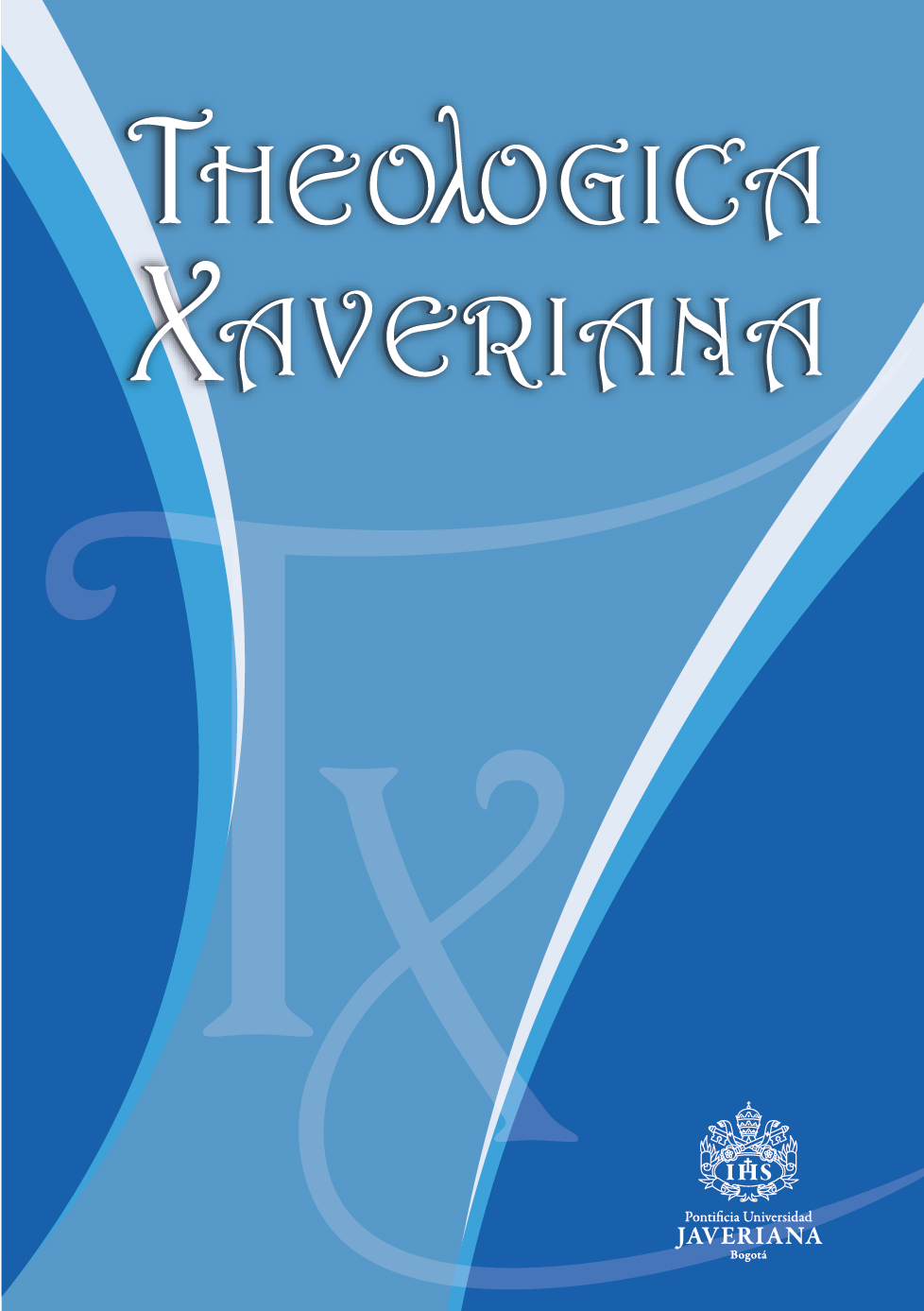El modelo de Iglesia como mystḗryon: la comprensión de kefalḗ y sỗma en Ef 5,21-33
##plugins.themes.bootstrap3.article.details##
En este artículo se analiza el modelo de Iglesia que se encuentra en Ef 5,21-33. El estudio se ocupa de la doble metáfora κεφαλή (cabeza) y σῶμα (cuerpo), así como su articulación con el concepto de μυστήριον (misterio). Al utilizar intuiciones procedentes de la retórica Antigua y moderna, y del análisis lingüístico cognitivo, demuestra que estas metáforas transmiten un modelo cristológico y ético. El estudio examina las interpretaciones feministas y emancipadoras de este pasaje, que ponen en primer plano las relaciones jerárquicas y propone, en su lugar, una lectura que promueve las relaciones recíprocas. Las metáforas revelan una visión transformadora de la Iglesia en cuanto plenitud de Cristo, perspectiva que reconfigura las normas culturales y sociales.
Ephesians 5:21-33, Head, Body, Metaphors, Church model, Mystery, Rhetoric, Cognitive LinguisticsEfesios 5,21-33, cabeza, cuerpo, metáforas, modelo de Iglesia, misterio, retórica, lingüística cognitiva
Aletti, Jean Noël. Essai sur l’ecclésiologie des lettres de Saint-Paul. Pendé: Gabalda, 2009.
Aletti, Jean Noël. “La eclesiología de las llamadas deuteropaulinas. Preguntas y propuestas.” Estudios Bíblicos 68/1 (2010): 53-71.
Aletti, Jean Noël. “Les difficulteés ecclésiologiques de la Lettre aux Éphésiens: de quelques suggestions.” Biblica 85/4 (2004): 457-474.
Aletti, Jean Noël. “Sagesse et mystère chez Paul. Réflexions sur le rapprochement de deux champs lexicographiques.” In La sagesse biblique: de l’Ancien au Nouveau Testament. Actes du 15e Congrès de l’Acfeb, edited by Jacques Trublet, 357–84. Paris: Du Cerf, 1995.
Aletti, Jean Noël. Saint Paul. Épître aux Éphésiens. Paris: Gabalda, 2001.
Armstrong, Karl L. “The Meaning of ὑποτάσσω in Ephesians 5.21-33: A Linguistic
Approach.” Journal of Greco-Roman Christianity and Judaism 13 (2017): 152-171.
Austin, John Langshaw. How to Do Things with Words. Oxford: Clarendon Press-Oxford University Press, 1962.
Bockmuehl, Markus N. A. Revelation and Mystery in Ancient Judaism and Pauline Christianity. Tubingen: Mohr Siebeck, 1990.
Caragounis, Chrys C. The Ephesian Mysterion. Lund: Gleerup, 1977.
De los Santos García, Edmundo. La novedad de la metáfora ΚΕΦΑΛΗ – ΣΩΜΑ en la Carta a los Efesios. Roma: Editrice Pontificia Università Gregoriana, 2000.
Egg, Markus. “Spatial Metaphor in the Pauline Epistles.” In Spatial Metaphors: Ancient Texts and Transformations, edited by Fabian Horn and Cilliers Breytenbach, 103-126. Berlin: Edition Topoi, 2016.
Esterhammer, Angela. Creating States: Studies in the Performative Language of John Milton and William Blake. Toronto: University of Toronto Press, 1994.
Gambadatoun, Yémadjro Fiacre Gilles. Connaître le mystere - Connaître la sagesse: La γνωσις et l’unité ecclésiale et cosmique en Éphésiens 3,1-13. Roma: Pontifical Biblical Institute, 2020.
Gil Arbiol, Carlos Javier. Escritos paulinos. Introducción al Estudio de la Biblia. Estella (Navarra): Verbo Divino, 2024.
Gil Arbiol, Carlos Javier. “La evolución de la imagen del cuerpo en la tradición paulina y sus consecuencias sociales y eclesiales”. Estudios Bíblicos 68/1 (2010): 73-105.
Ivarsson, Fredrik. “Christian Identity as True Masculinity.” In Exploring Early Christian Identity, edited by Bengt Holmberg, 159-171. Tübingen: Mohr Siebeck, 2008.
Köstenberger, Andreas J. “The Mystery of Christ and the Church: Head and Body, ‘One Flesh.’” Trinity Journal 12/1 (1991): 79-94.
Lausberg, Heinrich. Handbook of Literary Rhetoric: A Foundation for Literary Study. Leiden: Brill, 1998.
Lincoln, Andrew T. Ephesians. Dallas (TX): Word Books, 1990.
Low, Maggie. “An Egalitarian Marriage: Reading Ephesians 5:21-33 Intertextually with Genesis 2.” The Asia Journal of Theology 33/1 (2019): 3-19.
MacDonald, Margaret Y. “Colossians and Ephesians.” In T&T Clark Handbook to the Historical Paul, edited by Ryan S. Schellenberg and Heidi Wendt, 380-396. London: T&T Clark, 2022.
Mathewson, David L., and Elodie Ballantine Emig. Intermediate Greek Grammar: Syntax for Students of the New Testament. Grand Rapids (MI): Baker, 2016.
Metzger, Bruce Manning. A Textual Commentary on the Greek New Testament (4th ed.). Stuttgart: Deutsche Bibelgesellschaft; United Bible Societies, 1994.
Mollenkott, Virginia Ramey. “Emancipative Elements in Ephesians 5.21-33: Why Feminist Scholarship has (often) Left them Unmentioned, and Why they should be Emphasized”. In A Feminist Companion to the Deutero-Pauline Epistles, edited by Amy-Jill Levine and Marianne Blickenstaff, 37-58. London: Bloomsbury Academic, 2003.
Mouton, Elna. “Reimagining Ancient Household Ethos? On the Implied Rhetorical Effect of Ephesians 5:21-33.” Neotestamentica 48, no. 1 (2014): 163–85.
Mortara Garavelli, Bice. Manuale di retorica (7th ed.). Milan: Bompiani, 2003.
Penna, Romano. Il ‘Mysterion’ paolino. Brescia: Paideia, 1978.
Penna, Romano. La Lettera agli Efesini. Bologna: EDB, 1988.
Perelman, Chaïm, and L. Olbrechts-Tyteca. The New Rhetoric: A Treatise on Argumentation. Notre Dame (IN): University of Notre Dame Press, 1969.
Porter, Stanley E. Idioms of the Greek New Testament (2nd ed.). Sheffield: Sheffield Academic Press, 1996.
Quintilian. The Orator’s Education. Vol. III: Books 6-8. Edited and translated by Donald A. Russell. Cambridge (MA): Harvard University Press, 2002.
Reynier, Chantal. Évangile et mystère: les enjeux théologiques de l’Épître aux Éphésiens. Paris: Du Cerf, 1992.
Ricoeur, Paul. Interpretation Theory: Discourse and the Surplus of Meaning. Fort Worth (TX): Texas Christian University Press, 1976.
Schüssler Fiorenza, Elisabeth. Ephesians. Collegeville (MN): Liturgical Press, 2017.
Schüssler Fiorenza, Elisabeth. In Memory of Her: A Feminist Theological Reconstruction of Christian Origins. New York: Crossroad, 1983.
Schüssler Fiorenza, Elisabeth. “Paul and the Politics of Interpretation.” In Paul and Politics: Ekklesia, Israel, Imperium, Interpretation: Essays in Honor of Krister Stendahl, edited by Richard A. Horsley, 40-57. Harrisburg (PA): Trinity Press International, 2000.
Scott, James M. “Cosmopolitanism in Gal 3:28 and the Divine Performative Speech-Act of Paul’s Gospel.” Zeitschrift für die neutestamentliche Wissenschaft und die Kunde der älteren Kirche 112/2 (2021): 180-200.
Vrey, Aletta. “The Body Metaphor Reinforcing the Identity of the In-Group in Ephesians.” Neotestamentica 53/2 (2019): 375-393.

Esta obra está bajo una licencia internacional Creative Commons Atribución 4.0.


